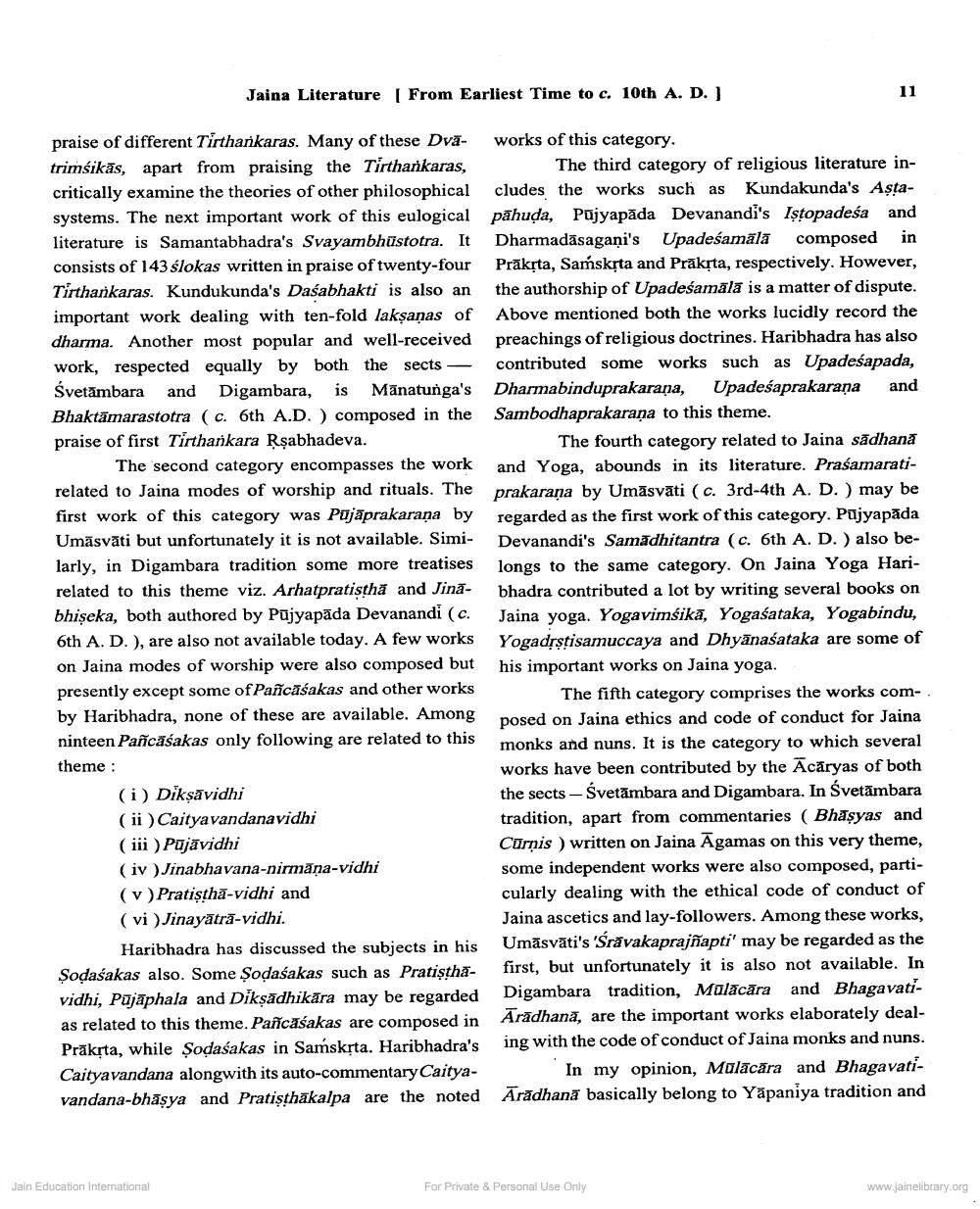________________
Jaina Literature | From Earliest Time to c. 10th A. D.)
praise of different Tirtharkaras. Many of these Dvā- works of this category. trimśikās, apart from praising the Tirthankaras,
The third category of religious literature incritically examine the theories of other philosophical cludes the works such as Kundakunda's Astasystems. The next important work of this eulogical pāhuda, Pajyapāda Devanandi's Istopadeśa and literature is Samantabhadra's Svayambhūstotra. It Dharmadāsagani's Upadeśamālā composed in consists of 143 ślokas written in praise of twenty-four Prākrta, Samskrta and Prakrta, respectively. However, Tirtharkaras. Kundukunda's Daśabhakti is also an the authorship of Upadeśamālā is a matter of dispute. important work dealing with ten-fold laksanas of Above mentioned both the works lucidly record the dharma. Another most popular and well-received preachings of religious doctrines. Haribhadra has also work, respected equally by both the sects — contributed some works such as Upadeśapada, Svetambara and Digambara, is Mānatunga's Dharmabinduprakarana, Upadeśaprakarana and Bhaktāmarastotra (c. 6th A.D. ) composed in the Sambodhaprakaraņa to this theme. praise of first Tirtharkara Rşabhadeva.
The fourth category related to Jaina sādhana The second category encompasses the work and Yoga, abounds in its literature. Praśamaratirelated to Jaina modes of worship and rituals. The prakarana by Umāsvāti (c. 3rd 4th A. D. ) may be first work of this category was Pujāprakarana by regarded as the first work of this category. Pujyapāda Umāsvāti but unfortunately it is not available. Simi- Devanandi's Samadhitantra (c. 6th A. D. ) also belarly, in Digambara tradition some more treatises longs to the same category. On Jaina Yoga Harirelated to this theme viz. Arhatpratistha and Jinā- bhadra contributed a lot by writing several books on bhiseka, both authored by Pujyapāda Devanandi (c. Jaina yoga. Yogavimsikā, Yogaśataka, Yogabindu, 6th A. D. ), are also not available today. A few works Yogadrstisamuccaya and Dhyanaśataka are some of on Jaina modes of worship were also composed but his important works on Jaina yoga. presently except some of Pañcāśakas and other works
The fifth category comprises the works comby Haribhadra, none of these are available. Among
posed on Jaina ethics and code of conduct for Jaina ninteen Pañcaśakas only following are related to this
monks and nuns. It is the category to which several theme :
works have been contributed by the Ācāryas of both (i) Dikṣāvidhi
the sects - Svetāmbara and Digambara. In Svetāmbara (ii) Caityavandanavidhi
tradition, apart from commentaries (Bhāşyas and (iii) Pājāvidhi
Carnis ) written on Jaina Āgamas on this very theme, (iv)Jinabhavana-nirmana-vidhi
some independent works were also composed, parti(v) Pratisthā-vidhi and
cularly dealing with the ethical code of conduct of (vi) Jinayātrā-vidhi.
Jaina ascetics and lay-followers. Among these works, Haribhadra has discussed the subjects in his Umāsvāti's 'Srăvakaprajñapti' may be regarded as the Sodaśakas also. Some Sodasakas such as Pratistha - first, but unfortunately it is also not available. In vidhi, Pūjāphala and Diksādhikāra may be regarded Digambara tradition, Malācāra and Bhagavatias related to this theme. Pancasakas are composed in Aradhana, are the important works elaborately dealPrākrta, while Sodasakas in Sanskrta. Haribhadra's ing with the code of conduct of Jaina monks and nuns. Caityavandana alongwith its auto-commentary Caitya
In my opinion, Mulācāra and Bhagavativandana-bhāsya and Pratisthākalpa are the noted Aradhana basically belong to Yapaniya tradition and
Jain Education International
For Private & Personal Use Only
www.jainelibrary.org




